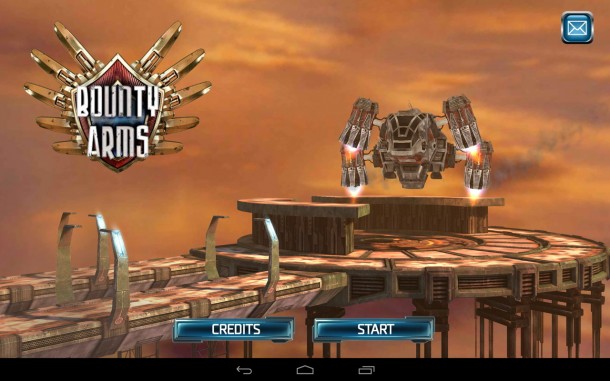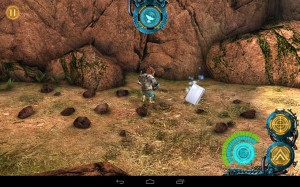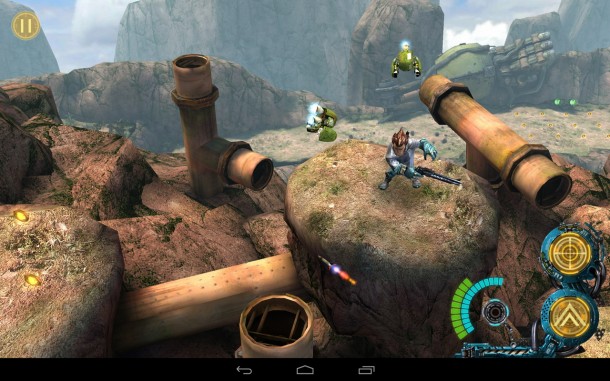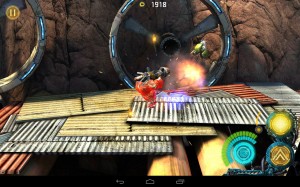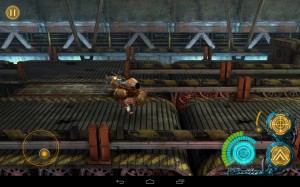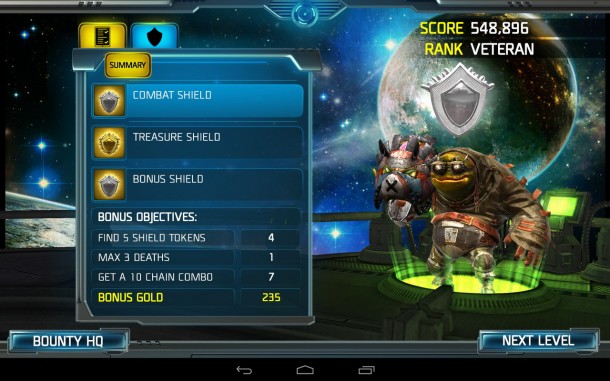I have nothing but love for Kerosene Games and Luma Arcade, the companies behind one of my favorite mobile titles, Bladeslinger. If you’ve played the game you know about the great graphics, unique gameplay, and cool story tying everything together. If you haven’t (and I’m trying to think of a nice way to put this) move out from under your rock and get some taste in mobile games, son, because you’re missing out.
Bounty Arms, the second Kerosene-Luma collaboration to hit the Play Store’s, uh, shelves, isn’t quite on Bladeslinger’s level, in my opinion. This is partially due to the fact that Bladeslinger is fricking awesome and partially because the new game has a few flaws that kept me from fully enjoying it. Does that mean it’s bad? No. Is it still a top-shelf title with a bunch of unique features and fun gameplay like its predecessor? Absolutely. Why is there a third question here? To make the paragraph flow better. I’m a “professional” writer, after all.
Shoot, Smash, Slaughter
You’ll spend your time with Bounty Arms controlling one of three bounty hunters: Flux (a hovering robot), Drake (a prunefaced human who kind of looks like a deformed James Dean), or Goober (a… frog… thing?). Each carries a gun, which is used to dispatch long-range and aerial enemies, and a short-ranged melee attack for baddies with fewer personal space boundaries. All three come with definite advantages and drawbacks, as well. Goober’s rocket launcher, for instance, does a ton of damage on impact, but is far slower than Drake’s shotgun or rifle or whatever the hell it is, which itself doesn’t seem to reach as far as Flux’s laser beam.
Levels to Die For
Like Bladeslinger before it, Bounty Arms features great level design, with unique, visually interesting envionments tailored perfectly to the gameplay. They aren’t just set up for killing, either. Finishing a segment to completion involves all kinds of third-person gaming staples – exploring, finding hidden items, collecting coins, etc. – and it works beautifully within the context of the game. It even manages to work in some semi-serious platforming elements like precision jumps and conveyor belt floors. Can you tell I’m nerding out yet?
If not, check this… it has a performance ranking system. That’s right. It shouldn’t be that surprising on the platform that brought us Angry Birds and its much-copied three-star grading scheme, but man does it add crazy replay value. Tons of factors, from the number of enemies you kill to the coins you collect to the hidden items you find, determine which tier you get when you complete a level. This is where I’d casually mention how frequently I ended up in the top tier if I was the kind of jerk and/or nerd to brag about my video game accomplishments like that. Seriously, though, I was mostly top-level. Just saying.
Good Visuals… as Expected
Let’s turn back to Bladeslinger for a second. If you seriously own a compatible Android device and haven’t played it yet, be sure to check out some of the screenshots on our recent review or the video on our product page to get an idea of how good the visuals are – then prepare to be at least marginally impressed when I tell you Bounty Arms looks better. Quite a bit better, in fact. I have some gripes related to technical bugs like jaggies and the occasional missing texture, which I’ll discuss in more detail a little further down, but overall it’s the kind of game that makes you stop and reflect how much of the gap mobile games have bridged between themselves and console titles in the last five years. It won’t be long until things converge on that front. This is just more proof of that.
Extras, Schmextras
Now begins the gripening (And yes, I did spell it like that. It sounds super dramatic). To start, the pet system, crucial as it might be a little later in the game, felt shoehorned and frankly a little useless during my time with the title. In theory, using the sidekicks’ unique abilities in tandem with your chosen bounty hunter adds even more replay value to a title already dripping with it by giving you multiple combinations of game-altering abilities. In practice, on the other hand, I had to keep reminding myself to use the things. Though I have yet to reach the endgame at a high difficulty level, where I suspect a flying bug or robot buddy would be a huge help, the system didn’t really feel like it belonged in the game. Or something. I can’t put to words exactly what I mean. It didn’t jive with everything else, I guess. Professional writer indeed.
We touched on my other, larger complaint above. Be it my device, a Nexus 10, or the game itself, I ran into several odd visual bugs that really hampered my experience. The jaggies were particularly bad here; I couldn’t count the times the level or my character decided it wasn’t on a high-end tablet anymore and decided to look like it came out of a bad PS2 game instead. I say all this knowing the platform isn’t as powerful as a console and granting it a little extra slack because it does manage to look so good most of the time. Despite taking that all into consideration it was frequent and noticeable enough to be annoying. Borderline really annoying, even, which we all know is a lot worse.
Worth the Dough
Bounty Arms costs five smackers on the Play Store. It’s more expensive than most games at that price. It doesn’t matter. Buy it. Like I’ve said here before, the fact that you’re reading this review means there’s a pretty good chance you’re someone who owns an Android device and is interested in gaming. If that’s the case, trust me when I say this is not a game you want to pass up. As volatile as the mobile game market can be, I’m confident in saying it’ll still be on some best-of-the-year type lists four or five months from now. It will be on mine, anyway, which means I’m technically correct no matter what happens. In the end, that’s all I really care about anyway.
